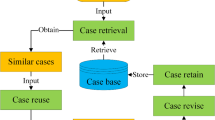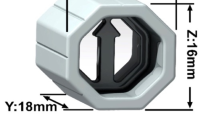Abstract
Surface roughness is an essential technical indicator for the surface quality of machined parts and significantly affects the service performance of the products. Accurate prediction of the surface roughness in the machining process can play an important role in reducing costs and increasing efficiency. However, data-based methods often require a large sample size for model training to improve prediction accuracy. Obtaining a sufficient number of training samples is challenging due to cost and efficiency constraints. To this end, an interpolation-based virtual sample generation scheme is proposed in this article, which utilizes a broad learning system (BLS) to generate virtual samples of the cutting groove surface roughness. Experimental verification was carried out in an ultra-precision machining center, where depth of cut and cutting speed were selected as inputs to the BLS. The results reveal that the proposed virtual sample generation approach can considerably improve the surface roughness prediction accuracy. Compared to other machine learning methods, BLS has the highest error reduction rate with and without virtual samples.










Similar content being viewed by others
References
Benardos, P., & Vosniakos, G.-C. (2003). Predicting surface roughness in machining: A review. International Journal of Machine Tools and Manufacture, 43(8), 833–844.
Chaudhari, A., Soh, Z. Y., Wang, H., & Kumar, A. S. (2018). Rehbinder effect in ultraprecision machining of ductile materials. International Journal of Machine Tools and Manufacture, 133, 47–60.
Chen, C. P., & Liu, Z. (2017). Broad learning system: An effective and efficient incremental learning system without the need for deep architecture. IEEE Transactions on Neural Networks and Learning Systems, 29(1), 10–24.
Chen, Y., Sun, R., Gao, Y., & Leopold, J. (2017). A nested-ann prediction model for surface roughness considering the effects of cutting forces and tool vibrations. Measurement, 98, 25–34.
Chen, J., & Zhao, Q. (2015). A model for predicting surface roughness in single-point diamond turning. Measurement, 69, 20–30.
Dong, M., & Wang, N. (2011). Adaptive network-based fuzzy inference system with leave-one-out cross-validation approach for prediction of surface roughness. Applied Mathematical Modelling, 35(3), 1024–1035.
Gong, X., Zhang, T., Chen, C. P., & Liu, Z. (2021). Research review for broad learning system: Algorithms, theory, and applications. IEEE Transactions on Cybernetics. https://doi.org/10.1109/TCYB.2021.3061094.
Grzenda, M., & Bustillo, A. (2013). The evolutionary development of roughness prediction models. Applied Soft Computing, 13(5), 2913–2922.
Guo, J., Zhang, J., Wang, H., Liu, K., & Kumar, A. S. (2018). Surface quality characterisation of diamond cut v-groove structures made of rapidly solidified aluminium rsa-905. Precision Engineering, 53, 120–133.
He, Y.-L., Hua, Q., Zhu, Q.-X., & Lu, S. (2022). Enhanced virtual sample generation based on manifold features: Applications to developing soft sensor using small data. ISA Transactions, 126, 398–406.
Ho, W.-H., Tsai, J.-T., Lin, B.-T., & Chou, J.-H. (2009). Adaptive network-based fuzzy inference system for prediction of surface roughness in end milling process using hybrid taguchi-genetic learning algorithm. Expert Systems with applications, 36(2), 3216–3222.
Huang, P. B., Zhang, H.-J., & Lin, Y.-C. (2019). Development of a grey online modeling surface roughness monitoring system in end milling operations. Journal of Intelligent Manufacturing, 30(4), 1923–1936.
Kannadasan, K., Edla, D. R., Yadav, M. H., & Bablani, A. (2020). Intelligent-anfis model for predicting measurement of surface roughness and geometric tolerances in three-axis cnc milling. IEEE Transactions on Instrumentation and Measurement , 69(10), 7683–7694.
Kong, D., Zhu, J., Duan, C., Lu, L., & Chen, D. (2020). Bayesian linear regression for surface roughness prediction. Mechanical Systems and Signal Processing, 142, 106770.
Kong, D., Zhu, J., Duan, C., Lu, L., & Chen, D. (2021). Surface roughness prediction using kernel locality preserving projection and bayesian linear regression. Mechanical Systems and Signal Processing, 152, 107474.
Li, L., Damarla, S. K., Wang, Y., & Huang, B. (2021). A gaussian mixture model based virtual sample generation approach for small datasets in industrial processes. Information Sciences, 581, 262–277.
Lin, W., Lee, B., & Wu, C. (2001). Modeling the surface roughness and cutting force for turning. Journal of Materials Processing Technology, 108(3), 286–293.
Li, B., & Tian, X. (2021). An effective pso-lssvm-based approach for surface roughness prediction in high-speed precision milling. Ieee Access, 9, 80006–80014.
Liu, N., Wang, S., Zhang, Y., & Lu, W. (2016). A novel approach to predicting surface roughness based on specific cutting energy consumption when slot milling al-7075. International Journal of Mechanical Sciences, 118, 13–20.
Liu, L., Zhang, X., Wan, X., Zhou, S., & Gao, Z. (2022). Digital twin-driven surface roughness prediction and process parameter adaptive optimization. Advanced Engineering Informatics, 51, 101470.
Lo, S.-P. (2003). An adaptive-network based fuzzy inference system for prediction of workpiece surface roughness in end milling. Journal of Materials Processing Technology, 142(3), 665–675.
Lu, C. (2008). Study on prediction of surface quality in machining process. Journal of Materials Processing Technology, 205(1–3), 439–450.
Mahesh, G., Muthu, S., & Devadasan, S. (2015). Prediction of surface roughness of end milling operation using genetic algorithm. The International Journal of Advanced Manufacturing Technology, 77(1), 369–381.
Manjunath, K., Tewary, S., Khatri, N., & Cheng, K. (2021). Monitoring and predicting the surface generation and surface roughness in ultraprecision machining: A critical review. Machines, 9(12), 369.
Özel, T., & Karpat, Y. (2005). Predictive modeling of surface roughness and tool wear in hard turning using regression and neural networks. International Journal of Machine Tools and Manufacture, 45(4–5), 467–479.
Pan, Y., Kang, R., Dong, Z., Du, W., Yin, S., & Bao, Y. (2020). On-line prediction of ultrasonic elliptical vibration cutting surface roughness of tungsten heavy alloy based on deep learning. Journal of Intelligent Manufacturing, 33, 675–685.
Plaza, E. G., & López, P. N. (2018). Analysis of cutting force signals by wavelet packet transform for surface roughness monitoring in cnc turning. Mechanical Systems and Signal Processing, 98, 634–651.
Plaza, E. G., & López, P. N. (2018). Application of the wavelet packet transform to vibration signals for surface roughness monitoring in cnc turning operations. Mechanical Systems and Signal Processing, 98, 902–919.
Rifai, A. P., Aoyama, H., Tho, N. H., Dawal, S. Z. M., & Masruroh, N. A. (2020). Evaluation of turned and milled surfaces roughness using convolutional neural network. Measurement, 161, 107860.
Salgado, D. R., Alonso, F., Cambero, I., & Marcelo, A. (2009). In-process surface roughness prediction system using cutting vibrations in turning. The International Journal of Advanced Manufacturing Technology, 43(1), 40–51.
Samanta, B. (2009). Surface roughness prediction in machining using soft computing. International Journal of Computer Integrated Manufacturing, 22(3), 257–266.
Sarkheyli, A., Zain, A. M., & Sharif, S. (2015). Robust optimization of anfis based on a new modified ga. Neurocomputing, 166, 357–366.
Sharkawy, A. B., El-Sharief, M. A., & Soliman, M.-E.S. (2014). Surface roughness prediction in end milling process using intelligent systems. International Journal of Machine Learning and Cybernetics, 5(1), 135–150.
Svalina, I., Šimunović, G., Šarić, T., & Lujić, R. (2017). Evolutionary neuro-fuzzy system for surface roughness evaluation. Applied Soft Computing, 52, 593–604.
Tian, W., Zhao, F., Min, C., Feng, X., Liu, R., Mei, X., & Chen, G. (2022). Broad learning system based on binary grey wolf optimization for surface roughness prediction in slot milling. IEEE Transactions on Instrumentation and Measurement, 71, 1–10.
Tian, W., Zhao, F., Sun, Z., Zhang, J., Gong, C., Mei, X., et al. (2022). Prediction of surface roughness using fuzzy broad learning system based on feature selection. Journal of Manufacturing Systems, 64, 508–517.
Tsai, Y.-H., Chen, J. C., & Lou, S.-J. (1999). An in-process surface recognition system based on neural networks in end milling cutting operations. International Journal of Machine Tools and Manufacture, 39(4), 583–605.
Tseng, T.-L., Konada, U., & Kwon, Y. (2016). A novel approach to predict surface roughness in machining operations using fuzzy set theory. Journal of Computational Design and Engineering, 3(1), 1–13.
Wang, X., Liu, H., Li, L., & Zhang, Y. (2022). Dual adversarial learning-based virtual sample generation method for data expansion of soft senors. Measurement, 11198, 1409.
Wang, Y., Niu, M., Liu, K., Shen, M., Qin, B., & Wang, H. (2022). A novel data augmentation method based on coralgan for prediction of part surface roughness. IEEE Transactions on Neural Networks and Learning Systems. https://doi.org/10.1109/TNNLS.2021.3137172.
Wang, S., Xia, S., Wang, H., Yin, Z., & Sun, Z. (2020). Prediction of surface roughness in diamond turning of al6061 with precipitation effect. Journal of Manufacturing Processes, 60, 292–298.
Wen, L., Li, X., Gao, L., & Yi, W. (2016). Surface roughness prediction in end milling by using predicted point oriented local linear estimation method. The International Journal of Advanced Manufacturing Technology, 84(9), 2523–2535.
Yu, W., Lu, Y., & Wang, J. (2021). Application of small sample virtual expansion and spherical mapping model in wind turbine fault diagnosis. Expert Systems with Applications, 183, 115397.
Zain, A. M., Haron, H., & Sharif, S. (2010). Prediction of surface roughness in the end milling machining using artificial neural network. Expert Systems with Applications, 37(2), 1755–1768.
Zhang, Y., Lee, Y. J., Chang, S., Chen, Y., Bai, Y., Zhang, J., & Wang, H. (2022). Microstructural modulation of tial alloys for controlling ultra-precision machinability. International Journal of Machine Tools and Manufacture, 174, 103851.
Zhang, J., Lee, Y. J., & Wang, H. (2021). Surface texture transformation in micro-cutting of aa6061-t6 with the rehbinder effect. International Journal of Precision Engineering and Manufacturing-Green Technology, 8(4), 1151–1162.
Zhang, S., To, S., Wang, S., & Zhu, Z. (2015). A review of surface roughness generation in ultra-precision machining. International Journal of Machine Tools and Manufacture, 91, 76–95.
Zhu, Q.-X., Chen, Z.-S., Zhang, X.-H., Rajabifard, A., Xu, Y., & Chen, Y.-Q. (2020). Dealing with small sample size problems in process industry using virtual sample generation: A kriging-based approach. Soft Computing, 24(9), 6889–6902.
Acknowledgements
The authors would like to thank Mr. Nelson Yeo Eng Huat for his assistance in the experimental work.
Funding
This work was supported by the National Key Research and Development Program of China under grant number 2018AAA0101802, the Science and Technology Major Project of Shaanxi Province under grant number 2019ZDLGY01-05HZ, and the Singapore Ministry of Education under grant numbers MOE2018-T2-1-140, MOE-T2EP50120-0010.
Author information
Authors and Affiliations
Contributions
Conceptualization: Wenwen Tian, Hao Wang and Xuesong Mei; Resources: Hao Wang, Xuesong Mei; Data curation: Jiong Zhang, Fei Zhao; Methodology: Wenwen Tian, Jiong Zhang and Hao Wang; Formal analysis and investigation: Hao Wang, Xiaobing Feng and Guangde Chen; Writing - original draft preparation: Wenwen Tian, Jiong Zhang; Visualization and Software: Wenwen Tian, Jiong Zhang and Xiaobing Feng; Validation: Jiong Zhang, Fei Zhao; Writing - review and editing: Hao Wang, Fei Zhao; Funding acquisition: Fei Zhao, Hao Wang; Project administration: Xuesong Mei, Guangde Chen; Supervision: Hao Wang, Xuesong Mei and Guangde Chen. All authors read and approved the final manuscript.
Corresponding authors
Ethics declarations
Conflict of interest
The authors declare that there are no conflicts of interest in the implementation of this work.
Ethics approval
Not applicable
Consent to participate
Not applicable
Consent for publication
The authors consent that the work entitled as “Interpolation-based virtual sample generation for surface roughness prediction” for possible publication in Journal of Intelligent Manufacturing. The authors certify that this manuscript is original and has not been published in whole or in part nor is it being considered for publication elsewhere.
Additional information
Publisher's Note
Springer Nature remains neutral with regard to jurisdictional claims in published maps and institutional affiliations.
Rights and permissions
Springer Nature or its licensor (e.g. a society or other partner) holds exclusive rights to this article under a publishing agreement with the author(s) or other rightsholder(s); author self-archiving of the accepted manuscript version of this article is solely governed by the terms of such publishing agreement and applicable law.
About this article
Cite this article
Tian, W., Zhang, J., Zhao, F. et al. Interpolation-based virtual sample generation for surface roughness prediction. J Intell Manuf 35, 343–353 (2024). https://doi.org/10.1007/s10845-022-02054-4
Received:
Accepted:
Published:
Issue Date:
DOI: https://doi.org/10.1007/s10845-022-02054-4




